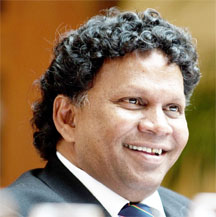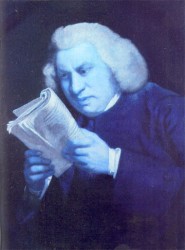(David Dabydeen Johnson’s Dictionary (Leeds, UK: Peepal Tree Press, 221 p.) Available in paperback)
Samuel Johnson’s A Dictionary of the English Language (1755) is regarded as an exceptional achievement produced by an eighteenth century scholar who is himself described as perhaps the most distinguished man of letters in English history. His dictionary, unique and remarkable in its time, was the authority on the English language right up until the production of the first Oxford English Dictionary some 150 years later. This outstanding work of lexicography goes further than a definition of words and according to his biographers it “offers insights into the eighteenth century and a faithful record of the language people used. It is more than a reference book; it is a work of literature.”
It is no surprise that this document serves as a reference point and lends a title to a remarkable novel about eighteenth century Britain and its infamous source of economic power – African slavery in the West Indies. David Dabydeen’s Johnson’s Dictionary is an outstanding master class in fiction writing. It is itself a brilliant document
One of the remarkable things about this novel is the thoroughness of its research. Dabydeen is himself a scholar and an authority on the eighteenth century – British society, slavery, the Abolition movement and the beginnings of Indian indentureship. The art of fiction is therefore served by a historian’s scrupulousness and a command of literature on which he draws for serious intertextuality as well as light references which are often evident in the most casual passing phrase. The book abounds in allusions to the Holy Bible, Roman Catholicism and different religions; to the Classics, Shakespeare, Adam Smith, William Hogarth; in addition to such personalities as Sir John Gladstone and, of course, Samuel Johnson. Yet all these references are deep, because of the eighteenth century significance of Gladstone, Smith and Hogarth and the strong theme and motifs of borrowings, imitation and false names/naming that are integral to the novel.
It is very readable, entertaining and engaging, although a complex and intellectually demanding novel, sometimes approaching Harrisian proportions. In multiple narratives it tells the story of Africans becoming victims, sold into slavery because of a breakdown in their cosmic order; of Manu the giver of names in Africa, recreated as a slave who has lost his name and how he ends up in the employ of the siren-like Elizabeth. It relates Elizabeth’s own harlot’s progress from early prostitution in London to plantation high society in Demerara; how Manu, renamed Francis, educates himself through reading Johnson’s dictionary and rises to a life of comfort, dispensing false names and false promises, imitating the white masters until he learns his true identity.

Dabydeen’s title, Johnson’s Dictionary, contains his first engagement of other texts. Manu, reappearing under the name Francis given to him by his owner Dr Gladstone (allusion to wealthy slave owner and British politician Sir John Gladstone), learns from daily reading of Dr Johnson’s magnum opus. This intertextual ploy lends Dabydeen’s novel one of its most striking features – its use of language. Interestingly, the very last word in the narrative is “words” while it opens with the phrase “These things he knew” – referring to Manu’s knowledge of tradition in his former life in Africa before things fall apart. In the end Francis discovers that his real name was Manu, as he stands on the Atlantic coast in British Guiana (Demerara) “screaming as if on the point of a nail but without sound, without the release, the relief, the closure of words.”
The great significance of this is the novel’s grand, complex but extremely neat structure. It ends as it began, because in its myth-like prologue, Manu loses his power to divine words and name babies and deserts his people, leaving them without names, tradition and identity. This betrayal leaves them powerless and the victims of slavers. In the end Manu stands at the place where the slavers deposited his people on the Atlantic shore feeling the guilt of his betrayal. He feels as if he is crucified “on the point of a nail” – the last of Dabydeen’s numerous Biblical/Christian allusions. After his education, in a mockery of his former life, he gives his fellow slaves false names because of his imitative mask as Francis, well versed in the Classics and English society. He who learnt words from Johnson’s Dictionary, and who was a master at using them, has now discovered who he really is, and therefore cannot find “the closure of words.”
Throughout, Dabydeen’s narratives are intensely sensitive to language. Throughout, the choice – the selection and use of English words is consistently stressed in the consciousness of Francis in particular, but also of other characters. Francis learns these words one by one as if he is naming the new world in which he finds himself; as if he has “Adam’s task of giving things their names” (as Derek Walcott puts it). But the sensitivity to language resonates in the various code switches which fits the narrators’ voices. For the most part, Francis as first person narrator uses a variety very close to the style and formal tones of eighteenth century English. But there are several switches into Guyanese Creole, subtly interspersed with the Standard English. This skin-tight deployment of language helps to give voice to the narrator.
Outstanding as it is, language is not the only factor in the thoroughness of this novel. The narration is multi-layered and seems to be telling the story of different persons at different times. But as the fairly elusive plot advances to its conclusion, these seemingly disparate plots fall neatly into place to reveal Dabydeen’s narrative design.

In the mythical Prologue Manu runs away from his village when his power to divine names fail him. He encounters a decrepit old woman in a deserted village. It can be assumed that the village had been emptied after it had been raided and its people sold into trans-Atlantic slavery. The old woman then begins to tell stories and the novel is actually the stories that she tells. After the fashion of Wilson Harris, this woman reappears in the plot as another significant character – that of Miriam, a virtual medicine woman (obeahwoman?), mentor and advisor to many slaves, as well as to Dr Gladstone, the white medical doctor who depends on her for his own divination and dispensary. Again, in Harrisian fashion, it turns out Miriam is actually the mother of each character whose story is told. Just as the old woman in Africa reveals truths to Manu, so does Miriam reveal hidden truths to Francis. It is through her that Francis discovers his true name (Manu) and identity.
Dabydeen’s attention to detail is meticulous. In the Prologue Manu meets the old woman in the deserted village when he was powerless and guilty of betraying his people and their vital traditions. She tells him the virtual story of slavery (which is fictionalised in the novel). Francis arrives at Miriam’s abode riding in the carriage of the “Massa” whose place he has assumed. He is dressed in the finery of the Massa, but changes his clothes when he gets there, putting on old garments that he used to wear. Very symbolically, when he leaves after Miriam’s story he forgets to change back into the fine clothes. Those are the garments of his imitation, and he unintentionally leaves them behind after his self-discovery.
Even the story of the harlot’s progress falls neatly into place as the London prostitute sails to Demerara where she assumes the identity of Lady Elizabeth. She moves easily into plantation society and becomes Mistress of the Revels, addressed as Lady Elizabeth. Her assumed identity strengthens the theme of prostitution in the fiction. It parallels the story of Francis who Elizabeth employs and who, like her, sells his talents, his loyalty, his identity, his very soul, justifying his actions with the pretence that he is accumulating money to buy freedom. Such freedom is ironic.
Additionally, Elizabeth’s story brings in relevant factors in England, such as the developing Abolitionist movement, the work of Adam Smith and of William Hogarth. Elsewhere, Dabydeen has studied the black characters who appear in Hogarth’s pictures, giving them life and significant meaning. He does this again in Johnson’s Dictionary. But the invocation of Hogarth is further significant. As an artist he is famous for his prints, paintings and cartoons such as ‘The Harlot’s Progress’ and ‘The Rake’s Progress,’ which “skewered the upper crust of eighteenth century society.” Similarly, Dabydeen’s satire of the same society reduces its politics, its morals, its corruption, its sugar plantations, to the power of a prostitute.
The relation to Hogarth is only one small part of this master class in the writing of fiction. It is a work of marked originality and freshness of treatment and approach to the unfathomable theme of slavery that is so often revisited. Dabydeen’s innovation gives it startling rebirth in ways that make the revisit well worth the trip.




